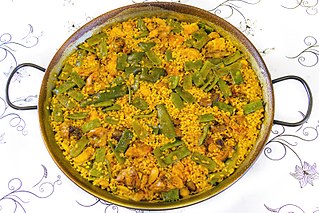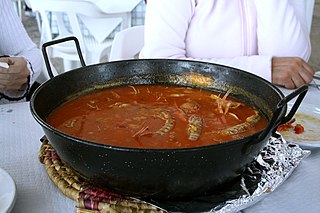
Paella is a rice dish originally from the Valencian Community. Paella is regarded as one of the community's identifying symbols. It is one of the best-known dishes in Spanish cuisine.

Horchata, or orxata, is a name given to various beverages, which are generally plant-based, but sometimes contain animal milk. In Spain, it is made with soaked, ground, and sweetened tiger nuts. In Latin America and other parts of the Americas, the base is jicaro, melon or sesame seeds, or white rice, along with other spices. Different varieties can be served hot or cold, and may be used as a flavor in other beverages, such as frappé coffee.

Rice pudding is a dish made from rice mixed with water or milk and other ingredients such as cinnamon, vanilla and raisins.

Arroz a la cubana or arroz cubano is a rice dish popular in several Hispanic countries. Its defining ingredients are rice and a fried egg. A plantain or banana, and tomato sauce, are so frequently used as often to be considered defining ingredients. In Catalonia, sausages frequently stand in for the plantains. Its origin is not definitively known; various informal sources state without references that it originated in Peru, the Philippines, etc. Some authors consider that it may have originated from rice dishes with fried eggs from Cuba when it was a Spanish colony.

Mexican rice, also known as arroz a la mexicana, arroz mexicano, or arroz rojo in Spanish, is a Mexican side dish made from white rice, tomato, garlic, onion, and perhaps other ingredients. Mexican rice is almost always eaten as a complement to other dishes such as mole, refried beans, rotisserie chicken, carne asada, picadillo, tacos, fried fish, fried chicken, chiles rellenos, or vegetable soup.

Parboiled rice is rice that has been partially boiled in the husk. The three basic steps of parboiling are soaking, steaming and drying. These steps make the rice easier to process by hand, while also boosting its nutritional profile, changing its texture, and making it more resistant to weevils. The treatment is practiced in many parts of the world.

Nicaraguan cuisine includes a mixture of indigenous Native American cuisine, Spanish cuisine, and Creole cuisine. Despite the blending and incorporation of pre-Columbian and Spanish-influenced cuisine, traditional cuisine differs on the Pacific coast from the Caribbean coast. While the Pacific coast's main staple revolves around beef, poultry, local fruits, and corn, the Caribbean coast's cuisine makes use of seafood and coconut.

Rice and beans, or beans and rice, is a category of dishes from many cultures around the world, whereby the staple foods of rice and beans are combined in some manner. The grain and legume combination provides several important nutrients and many calories, and both foods are widely available. The beans are usually seasoned, while the rice may be plain or seasoned. The two components may be mixed together, separated on the plate, or served separately.

Picadillo is a traditional dish in many Latin American countries including Puerto Rico and Cuba as well as the Philippines. It is made with ground meat, tomatoes, and also raisins, olives, and other ingredients that vary by region. It is often served with rice or used as a filling in dishes such as tacos, savory pastries or croquettes. The name comes from the Spanish word picar, meaning "to mince".
Arroz con leche may refer to:

Arroz Con Habichuela (Rice With Bean) is the title of the 2006 studio album by El Gran Combo de Puerto Rico. The Spanish title of the album means "rice with beans" in English which is a popular plate both in Puerto Rico and throughout Latin America. It is also the first album featuring new member, Willie Sotelo, on piano who replaced longtime piano player, Rafael Ithier, so that Ithier could focus more on directing the band. Released by Sony International, the album garnered a radio hit with its first single, "No Hay Manera". The album also received the 2007 Latin Grammy Award for Best Salsa Album.

Arroz a la valenciana or Valencian rice is a name for a multitude of rice dishes from diverse cuisines of the world, which originate from the rice-cooking tradition of the Valencian Community, in eastern Spain.
Modesto Francisco Fernández Díaz-Silveira is a Cuban government official that travels often around the world talking about the environment.

Kamby arro is a popular dessert in Paraguay. It is a variation of arroz con leche, a rice pudding produced from cooked rice and cow's milk.

Arroz con gandules is a combination of rice, pigeon peas, and pork, cooked in the same pot with sofrito. This is Puerto Rico's national dish along with roasted pork.

Arroz chaufa, also known as arroz de chaufa, is a fried rice dish from Peru. It is part of the Chinese Peruvian cuisine, which is called chifa.

Arroz Caldoso is a dish which originated in Spain. It literally means "brothy rice" and consists of broth (bouillon) and rice with diverse flavourings and extra ingredients. The recipe is quite varied depending in which region of the Iberian peninsula it is prepared. Variations of this dish range from a recipe quite similar to Italian risotto, to a rice soup, to a dish that could be mistaken for paella.

Arroz negro is a Mexican dish made with rice, in which its dark color comes from black bean broth. The dark broth is made by cooking black beans with onion and butter in sufficient water. Rice is fried with garlic, then the bean broth is added, as well as epazote, serrano pepper, and salt. The rice is simmered until tender.

Arabic rice or rice with vermicelli is a traditional preparation of rice in the Middle East, a variant of the simpler cooked rice recipe, but adding lightly toasted vermicelli. The rice cooking method is known as pilaf, by which the rice is fluffy, light and does not stick. Traditionally, a long-grain rice, such as basmati or jasmine, is used, although short-grain rice, such as bomba or misri ("Egyptian"), can be used perfectly. Brown rice can also be used.

















